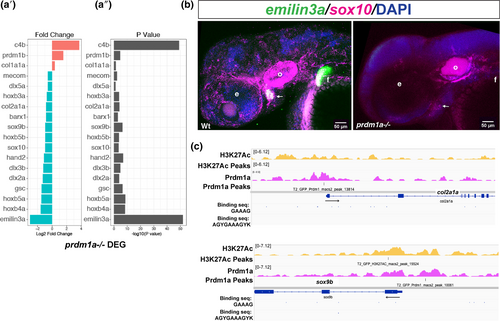
RNA-seq results suggest loss of Prdm1a leads to a significant decrease in genes required for craniofacial development. RNA-seq was previously performed on Tg(Mmu:Prx1-EGFP) wildtype and prdm1a−/− embryos at 48 hpf (Truong et al., 2023). We reanalyzed the dataset and replotted the data. (a′) Bar plot showing the log2 fold change of differentially expressed genes in prdm1a−/− compared with wildtype. Orange bars are upregulated, while teal bars are downregulated. (a″) Bar plot showing the p-values of differentially expressed genes from RNA-seq dataset. (b) Hybridization chain reaction in situ hybridization of emilin3a (green), sox10 (pink) and DAPI (blue) in wildtype and prdm1a−/− mutants at 48 hpf. White color indicates expression overlap (n = 6 prdm1a mutants). (C) CUT&RUN was previously performed on Tg(Mmu:Prx1-EGFP) wild-type embryos at 24 hpf (Truong et al., 2023). Tracks showing H3K27Ac enrichment (open chromatin) and Prdm1a binding sites for sox9b and col2a1a. Binding site sequence for Prdm1a, both the conserved core (GAAAG) and long sequence (AGYGAAAGYK), are shown as blue marks below the tracks. e, eye; f, fin; o, otic vesicle.
|

